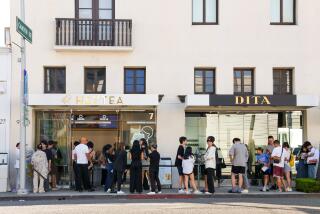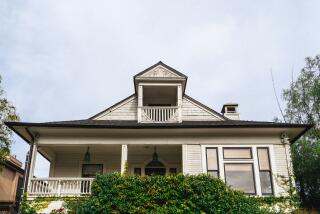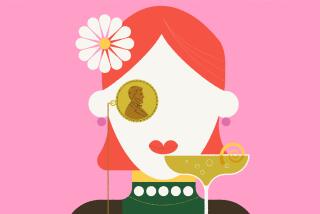Tea for you ... and you ... and you: How the boom in the brew can fuel your travel
Some people say the British drama “Downton Abbey” put tea on the front burner; others say it was Queen Elizabeth’s 90th birthday celebration. Or maybe people are just bored with coffee.
Whatever the reason, interest in tea is booming, which you’ll find when you travel nearly anywhere.
More than 158 million Americans sip it, hot or cold, on any given day. Four in five U.S. consumers drink tea, according to the Tea Assn. of the USA Inc.
Baby boomers are big fans, but millennials are the most likely tea drinkers, the association said: A whopping 87% choose it.
With the beverage’s upswing in popularity, the British pastime of tea is surging in high-end hotels worldwide.
It has become so popular at the Four Seasons Resort the Biltmore Santa Barbara that the Saturday afternoon tea often is booked three weeks in advance.
The tradition “is passed down from generation to generation,” said Koji Akaboshi, food and beverage director. “We’re seeing daughters who used to come with their mother join us with their own children now.”
At most places the menu includes scones, finger sandwiches, sweets and an occasional glass of Champagne.
I like all of those — and tea too — so I decided to create my own special tour, sampling the fare at some of the swankiest hotel tearooms in the world.
My travel schedule last year took me to Britain and several former British outposts where elaborate afternoon teas are common.
Pinkies at the ready? Have a cup of tea with me at five places where Lipton teabags probably aren’t on the menu.
Fairmont Empress Hotel, Victoria, Canada
Victoria is one of my favorite North American cities: a postcard-pretty provincial capital full of lush gardens and historic buildings.
The Fairmont Empress is more than 100 years old and so renown that it is one reason people visit the city.
That’s as good a reason as any to indulge in its famed afternoon tea, which is served in the Lobby Lounge, with a view of Victoria’s charming Inner Harbour.
The hotel is undergoing a $40-million renovation. Phase One was finished last summer, infusing a modern design but maintaining classic details. The lounge area where tea is served has been refurbished so guests see a prettier face.
Some new details have also been added to upgrade the tea experience. I especially liked the wooden book-like menu that opens to reveal small compartments full of loose-leaf teas.
You can choose from 21 teas, including the Empress and rare Tong Mu Phoenix Lapsang Souchong blends, and you’ll drink from custom Royal Doulton china. The hotel has used the china since the royal visit by King George VI and Queen Elizabeth in 1939.
But let’s get to the good stuff: salmon pinwheels, turkey breast and English cucumber sandwiches and the wonderful chocolate dome tart.
The Empress’ tea offers a lovely diversion on a sunny Victoria Island day, or on a rainy island day, for that matter.
Reserve two weeks in advance.
Info: Tea at The Empress, 721 Government St., Victoria; Canada; (250) 384-8111. Tea $57 per person; $80 with a glass of Veuve Clicquot Champagne.
Lanesborough, London
Ah, London. So many wonderful tearooms, so little time.
I took a cue from Condé Nast Traveller (the British version) and visited the magazine’s fave for tea connoisseurs: the Lanesborough, a Regency-era gem known for classically British service.
If you’re looking for genteel London glamour, this is the place. The Knightsbridge hotel, on Hyde Park Corner across from Buckingham Palace, reopened in 2015 after a multimillion-dollar, two-year renovation.
It caters to the well-heeled, with 93 individually decorated rooms, including 43 suites. One of these, the royal suite, has seven bedrooms and goes for $22,000 a night.
I joined three friends here for tea one afternoon last summer, settling into a booth in a richly decorated room flooded with natural light. (In the evening, it becomes the setting for Céleste, the hotel’s Michelin-starred restaurant.)
The tea menu was nine pages and included black, green, white, oolong, herbal, decaffeinated, fruit/ice teas and premiums.
Top of the line seemed to be Darjeeling First Flush Goomtee; the menu explained that first flush teas are sometimes referred to as the Champagne of Indian tea because of their flowery, aromatic character.
I passed. Its premium price would have added $18.50 to the bill.
I didn’t pass, however, on the additional $16 charge for a class of Taittinger Champagne.
Tea and Champagne are a truly excellent combination, especially when accompanying Scottish salmon and caviar finger sandwiches, chocolate cupcakes, apple tarts and cashew nut brownies. And, of course, fresh strawberries and sorbet with vanilla cream.
Info: Hyde Park Corner, London; 011-44-20-7333-7254, www.lanesborough.com. Tea $64 per person, $80 with Champagne.
The Ritz, Paris
It may seem odd to include a French hotel on this list. But the Ritz, a Parisian grande dame, offers an excellent tea although it’s a bit different from British teas.
“It’s French tea,” said Steve Cochon, the hotel’s tea sommelier.
“We only do sweets with tea, no savories,” he said, referring to the finger sandwiches that Brits include in a tea service.
Another thing that puts this hotel on our list: It’s well worth a visit after its recent reopening following a four-year, $420-million renovation.
The Place Vendôme hotel, which shares the elegant 18th century square with some of the world’s most exclusive jewelry stores, has a storied history.
Coco Chanel lived here, Princess Diana ate her last meal here, and Ernest Hemingway supposedly led its liberation from the Nazis. (There’s debate about how much liberating was needed by the time the author arrived.)
The elegant new tearoom is in Salon Proust, named for writer Marcel Proust. “He used to sit over there by the fireplace,” Cochon said.
The Ritz menu includes more than two dozen teas, including fermented teas and herbal infusions. The sweets are wonderfully sweet, a combination of petits fours, brioches, marble cake, tarts and madeleines, of course.
Info: 15 Place Vendôme, Paris; 011-33-1 43-16-30-30, www.ritzparis.com. Tea $57.50; with Ritz Champagne, $78.50.
Raffles Hotel, Singapore
Raffles, known for its afternoon tea service and for inventing the fruit-flavored Singapore Sling cocktail, has served a glittering list ois f celebrities, statesmen, royalty and authors during its 129-year history.
Suites are named for Joseph Conrad, who visited in 1887; Rudyard Kipling, an 1889 visitor; and Noel Coward, who visited frequently for nearly 40 years.
And, of course, there’s James Michener, who once reminisced, “To have been young and had a room at Raffles was life at its best.”
I didn’t have a room here, but I spent a couple of pleasant hours enjoying the tea service, which is very British, complete with three-tiered stand, cucumber and cream cheese finger sandwiches, chocolate praline cake, scones with clotted cream and strawberry jam, and several teas and coffees from which to choose.
Raffles, in a nod to its locale, adds buffet items that give this tea another dimension: savory dim sum, chicken curry pie and croque-monsieur.
Reserve well in advance if you’d like to try Raffles’ tea. It has become so popular that the hotel no longer advertises it, and “we don’t recommend it to our guests because they can’t get in,” my server told me.
Info: 1 Beach Road, Singapore; 011-65-64-12-18-16, www.raffles.com/singapore. Tea $46 per person; add $19 with Champagne.
Peninsula Hong Kong, Hong Kong
The setting here is everything a visitor could wish for: a beautiful, high-ceiling lobby with soaring columns, graceful palm trees and the Lobby Strings playing classical music in the background.
Perhaps that’s why the Peninsula Hong Kong‘s afternoon tea has become so in demand. And it doesn’t hurt that you don’t need reservations, a rarity among popular afternoon tea venues.
The downside: It’s first-come, first-served, meaning you should get in line well before the 2 p.m. start. (Tea service concludes at 6 p.m.)
The menu was standard: finger sandwiches and savory pastries, raisin scones with clotted cream and strawberry preserves, served on tiered silver cake stands. A large choice of teas and coffees, which are poured from vintage Sheffield silver, is offered. All of it was nicely done.
And I loved the atmosphere. I closed my eyes and felt as though I was in London instead of halfway across the world.
Be sure to allow yourself time to explore the hotel’s three-floor shopping arcade, which has more than 80 shops.
Info: Salisbury Road, Kowloon, Hong Kong; 011-852-2920-2888, www.hongkong.peninsula.com. Tea $46 per person; $69 with Champagne.
Is it afternoon tea? Or high tea?
Most people, especially in the United States, use the terms interchangeably and, purists would say, incorrectly. There are differences, according to TeaTime Magazine.
“High tea is not a fancy tea, as many people assume,” said TeaTime in a July article.
“Delectable scones, tea sandwiches, and cakes are the hallmark of an afternoon tea, which is served in mid-afternoon.
“A high tea, however, includes much more substantive fare, such as meat, fish and egg dishes, as well as breads and desserts, and is offered in the early evening.
“Think of it as a light supper served with tea.”
Afternoon tea is often credited as a British invention. About 1840, Anna, the Duchess of Bedford, decided to ward off “that sinking feeling” she had every afternoon by drinking tea accompanied by a light snack.
High tea, on the other hand, was a working-class invention. It was served each day around 6 p.m. when workers returned home ready for fish, meat, cheese and other hearty fare.
More tea trivia:
- According to legend, the story of tea began centuries earlier in China, when Shennong, a well-known herbalist, drank some boiled water in 2737 BC that contained leaves that had fallen into it from a tree.
- Iced tea’s popularity dates to 1904 during the St. Louis World’s Fair. It was so hot that Englishman Richard Blechynden dropped some ice into tea because it wasn’t selling. (Other sources contend that iced tea wasn’t invented here, having been served in the steaming hot South years before the fair.)
- Tea bags, which made their appearance about the same time as the World’s Fair, were hand-sewn fabric bags and were marketed in the United States by Thomas Sullivan, a tea and coffee shop merchant.
- Tea bags are no longer the darling of the industry, according to the Tea Assn. of the USA Inc. Their sales have remained flat while sales of ready-to-drink teas have skyrocketed, growing more than 15-fold during the last decade.
- Tea prepared at home costs about 3 cents a serving, the Tea Assn. says. Even more expensive teas increase that amount by about 7 cents a serving.
More to Read
Sign up for The Wild
We’ll help you find the best places to hike, bike and run, as well as the perfect silent spots for meditation and yoga.
You may occasionally receive promotional content from the Los Angeles Times.






